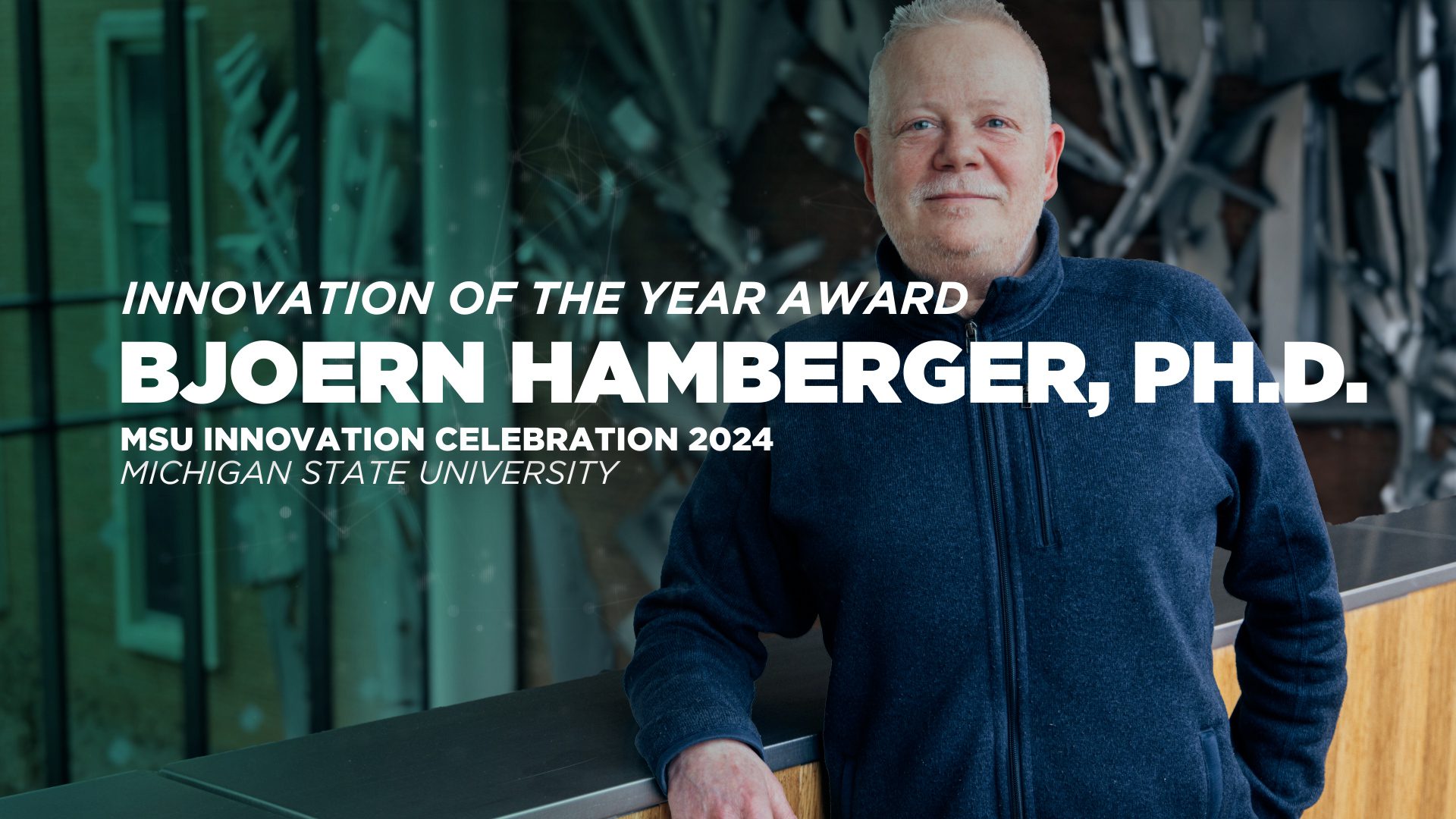East Lansing, MI – Björn Hamberger, an associate professor at Michigan State University (MSU) in the Department of Biochemistry and Molecular Biology, tells the story of a pre-homo sapiens man buried in a cave in Iraq surrounded by many flowering plants. “We know some of these plants today as powerful antimalarials,” says Hamberger. Humans knew those plants had medicinal value for tens of thousands of years.”
The subject of this year’s Innovation of the Year award is Hamberger’s groundbreaking research in the bioengineering of bacteria to produce terpenes, specifically carotenoids, which are valued chiefly as antioxidants and as pigments.
 “The terpene family of molecules is breathtaking in scope and enormously important, industrially, nutritionally, and pharmacologically,” says Joe Affholter, Commercialization Program Director for the MTRAC AgBio Innovation Hub at the MSU Innovation Center. “They’re important in practically every chemistry-oriented industry from foods and flavorings to pigments and coatings.”
“The terpene family of molecules is breathtaking in scope and enormously important, industrially, nutritionally, and pharmacologically,” says Joe Affholter, Commercialization Program Director for the MTRAC AgBio Innovation Hub at the MSU Innovation Center. “They’re important in practically every chemistry-oriented industry from foods and flavorings to pigments and coatings.”
Hamberger and his team have worked extensively with terpenes to create and identify unique metabolic pathways for making various products. He credits his research associate, Elhussiny Aboulnaga, with being instrumental in developing the award-winning technology and its two related patents.
“Hussiny’s background is in microbial engineering,” explains Hamberger. “And he had this crazy idea that we should try to engineer this food-safe bacterium that NASA has used to make protein for astronauts since the 1960s. It grows really well and grows to be very, very dense.”
 Leveraging the bacterium’s ability to feed on almost any carbon-based substance, Hamberger’s team engineered the bacterium to feed on glycerol and then trained it to form novel compounds, including carotenoids. “This technology is unique,” says Hamberger, “because here we are looking for the first time at microbial production of nutraceutical components.”
Leveraging the bacterium’s ability to feed on almost any carbon-based substance, Hamberger’s team engineered the bacterium to feed on glycerol and then trained it to form novel compounds, including carotenoids. “This technology is unique,” says Hamberger, “because here we are looking for the first time at microbial production of nutraceutical components.”
“One of the Holy Grails of biotechnology for more than 50 years has been the systematic programming of microbial organisms to create any biomaterial we want to. This creates a potentially powerful platform for producing hundreds of different, commercially valuable molecules with a very high yield at a low cost. It is a major technology breakthrough,” explains Affholter.
“There are lots of products you could make,” says Hamberger. “But I think the first one may be lycopene. It’s a name everybody knows. That’s the red of tomatoes, and it is a highly effective antioxidant. It’s a nutraceutical gold mine in terms of cardiovascular health, anti-aging – and we can’t get enough of it.”
“We are interested in developing the technology further for commercialization,” says Hamberger. “MSU Technologies has supported us massively, which has allowed us to develop it to the current stage.”
The technology is currently moving through a derisking process involving translational research funding from the MTRAC AgBio Innovation Hub. “We call it translational funding because it helps to ‘translate’ the technology from a laboratory success to a market-ready innovation,” says Affholter.
Both Hamberger and Affholter want students to understand the import their research carries beyond the lab. “They need to have a business mindset as they pursue their research,” says Hamberger. “One, they must be sure to secure their IP with MSU Technologies, and two, they need to be aware that there is a value and true business behind the research that they are doing.”
MSU is a university that places the highest value on outcomes that positively impact humanity. “But that impact will only be realized if successes like this are effectively commercialized,” says Affholter. “So, for technology innovations, impact on humanity requires commercialization. And greater impact often equates to greater success in the marketplace.”
Read more about the 2024 Innovation Celebration Award winners HERE.
###
About the MSU Innovation Center:
The MSU Innovation Center is dedicated to fostering innovation, research commercialization, and entrepreneurial activities from the research and discovery happening across our campus every day. We act as the primary interface for researchers aiming to see their research applied to solving real-world problems and making the world a better place to live. We aim to empower faculty, researchers, and students within our community of scholars by providing them with the knowledge, skills, and opportunities to bring their discoveries to the forefront. Through strategic collaborations with the private sector, we aim to amplify the impact of faculty research and drive economic growth while positively impacting society. We foster mutually beneficial, long-term relationships with the private sector through corporate-sponsored research collaborations, technology licensing discussions, and support for faculty entrepreneurs to support the establishment of startup companies.

